The AMD Threadripper 2 CPU Review: The 24-Core 2970WX and 12-Core 2920X Tested
by Ian Cutress on October 29, 2018 9:00 AM ESTThreadripper 2: Filling Out The Product Portfolio
With the quad silicon die strategy for Threadripper 2, there are plenty of ways that AMD could have chopped and changed the core counts to get various processors at various price points. For Intel, having a product at every pair of core counts seems to be integral to the company strategy, producing seven different processors from six cores to eighteen cores, whereas AMD has decided to split into 12, 16, 24, and 32.
We reviewed the 32-core Threadripper 2990WX and the 16-core Threadripper 2950X back in August. The results from that review were very mixed: the large 32-core behemoth was an absolute beast in non-communication limited workloads (either to memory or other cores), and absolutely broke down anything the competition had to offer. On the catch side, that didn’t apply to everything, and in the communication limited cases, the 2950X was preferred, especially as it was a lot cheaper. Expanding out to the quad-die strategy, as AMD has done, with two of those dies not being directly connected to memory, both helps and hinders performance. The upshot is that for the price of Intel’s 18-core, users could get 32-cores from AMD, if you can use them. In that review, out of the Threadripper family, we said that the 2950X was likely where users looking for the best performance per dollar were likely to end up.
Today sees the launch of the other two processors in the family, the 12-core 2920X and the 24-core 2970WX. There is ultimately less fanfare with these parts, being cut down versions of the previous two, and so on paper, given the same or lower frequencies, we would normally expect them to perform worse than the 2990WX and 2950X. This would be a good reason as to why they’ve been released a little bit later. In our performance testing, this kind of bears fruit, but not always.
In our power analysis, having fewer cores per die means that we see a sharper uptick in power consumption when threads are placed onto a new die. This is because the new die is ‘cool’, in the sense that nothing is running on it, and as a result the cut down dies actually hit their peak power sooner, which should translate into frequency. However, it really does depend on the workload, and most user workloads either use all of the cores, or just a few. In order to get the benefit here, we’re looking at multi-taskers.
For performance, in most multithreaded benchmarks we see the 2920X sitting below the 2950X, and the 2970WX sitting below the 2990WX. This is mostly because of core counts, but depending on how the benchmark scales and memory accesses, we do see the 2970WX sometimes go above the EPYC 7601 with its lower frequency, despite its higher memory bandwidth. At $1299, the 2970WX is going to be $500 cheaper than the 2990WX, which certainly makes it aggressive for price/performance.
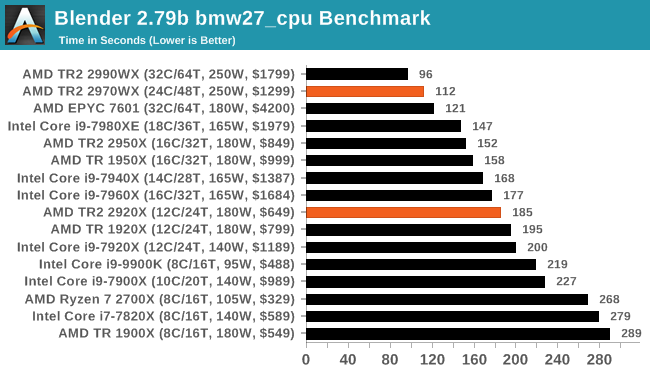
We do see on occasion that the 2970WX actually beats the 2990WX, such as in PhotoScan, 3DMark Physics and GeekBench, because there are fewer cores to compete for the inter-core bandwidth. However on the whole, the 2990WX does win out.
The 2920X is actually the baby of the Threadripper 2 family, so it really has to compete on price/performance to be noticed. The thing is, except for the true multi-threaded workloads, the Ryzen 7 2700X is going to be the better day-to-day chip. It all depends on if the TR2 system is going to run as a standalone workhouse, or as a true day-to-day machine. As a workhouse, it’ll go beyond the 2700X for sure.
How about if we compare AMD 12-core 2920X to Intel’s 12-core 7920X ?
If we take out the obvious AVX-512 wins for the i9-7920X, the Intel chip loses performance in the compile and web tests, but gains performance in encoding and system tests. Overall, these chips are around the same, except for the retail pricing: With AMD, you save 45%. That’s a no-brainer, right?
On the results overall, we can see why these two chips were launched later in the year compared to the 16-core and 32-core parts. They are more cost effective, although the performance is in line with the cost. Between all of the Threadripper parts, first generation and second generation, our recommendation is still on the TR2 2950X.
| AMD Related Reviews | |||
| Ryzen 7 2700X Review | Threadripper 1950X Review |
Threadripper 2 2990WX Review |
Best CPUs |
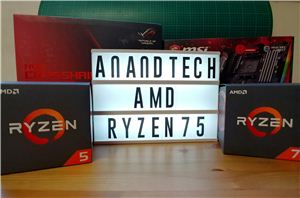 |
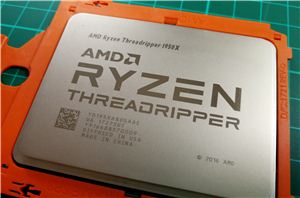 |
%20-%20Copya_678x452.jpg) |
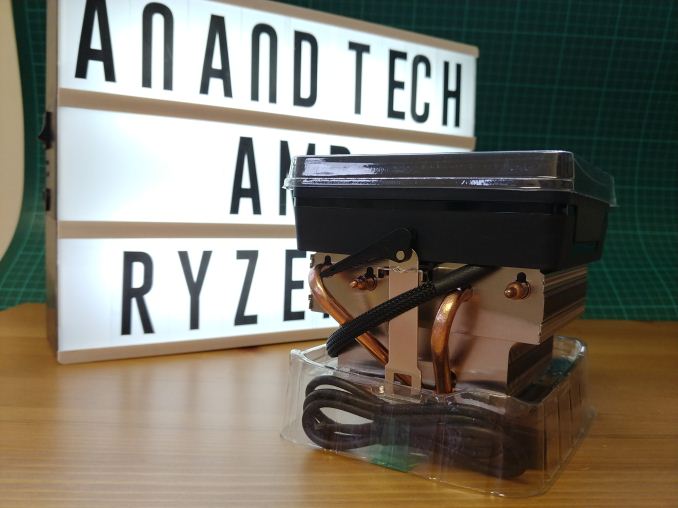 |
| ASUS X399 ROG Zenith Extreme |
ASRock X399 Pro Gaming |
GIGABYTE X399 Designare EX |
X399 Overview |
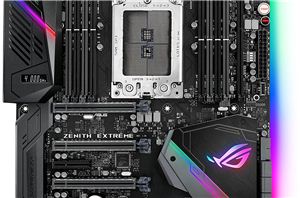 |
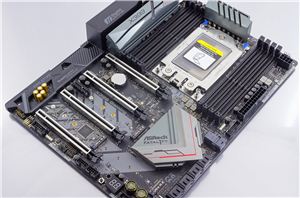 |
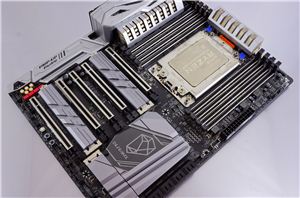 |
 |



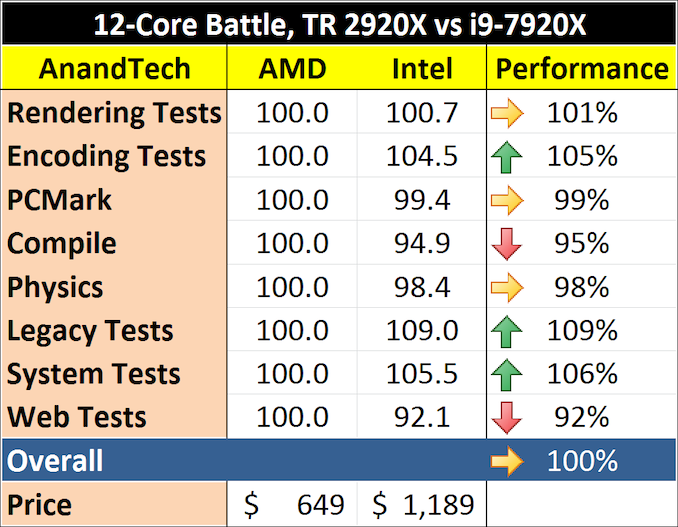








69 Comments
View All Comments
schujj07 - Monday, October 29, 2018 - link
You would be far to limited with RAM to run 60 VMs on that system. I've got 80 on dual Dell 7425's with dual 24 Core Epycs and 512GB RAM and I'm already getting RAM limited.Again I wouldn't install ESXi on these. Use Win 10 and Workstation for your test/dev and you will have a more agile system. If you don't need it for testing that day you still have Windows. FYI I'm VMware Admin.
Ratman6161 - Monday, October 29, 2018 - link
All depends...in my home lab environment (which lets me test things at will and do whatever I want as opposed to at work where even the lab is more locked down) . For me, the Threadrippers would be great...but extreme overkill. I actually use old FX8320's which I bought when they were dirt cheap and DDR3 RAM was cheap too. The free version of ESXi works fine for me too. For my purposes the threadrippers would be really cool but more expensive than they would be worth.Icehawk - Monday, October 29, 2018 - link
I would love one of these high cores boxes for our test lab, using W10 and VM on my desktop is very limiting for me (work rig is 7700 & 32gb) - one of these would let me put plenty of resources onboard. Currently my lab runs off a G6 Dell server which is totally fine but if I could get myself a new, personal, lab I'd want a TR rig since it can host a lot more RAM than Intel's option.odrade - Tuesday, October 30, 2018 - link
Hi I completely agree with you.With security enhancement moving to sandbox/VM (Application Guard, Sandboxed Defender in 19H1) virtualization scenario will be more prevalent beyond developper or test scenarios.
One major disappointment is that after 12+ months since GA there is no support for nested virtualization for TR/TR2 ?, Ryzen ? Epyc ?.
This issue seems to be general and not limited to hyper-v (KVM, etc..).
This is strange since EPYC made is way through Azure or Oracle Cloud catalog.
During Ignite 2018 there was a demo with an EPYC box (VM or Server).
Regards G.
GreenReaper - Wednesday, October 31, 2018 - link
You could ask for HyperV over here:https://windowsserver.uservoice.com/forums/295047-...
But such features are often buggy in their initial implementations:
http://www.os2museum.com/wp/vme-broken-on-amd-ryze...
https://www.reddit.com/r/Amd/comments/8ljgph/has_t...
It wouldn't surprise me if they ran into too many problems to want to push out a solution. And Intel has had issues here too - most recently L1 Terminal Fault relating to EPT:
https://www.redhat.com/en/blog/understanding-l1-te...
If people buy enough of them, and there is a performance benefit or it otherwise becomes a feature differentiator, support will doubtless be developed. Chicken and egg, I know.
odrade - Monday, November 5, 2018 - link
Hi,Thanks four your inputs.
This feature is handy if you want to build advanced lab scenarios while preserving your work environment or avoid the hassle to use dual boot.
Maybe this feature will be enabled with the 2019 Epyc / TR iteration.
And if the the socket and compatibility promises is kept by AMD refreshing
my setup will do it and put those extra pcie lanes to use (upgrading storage as well).
At least the 7mm process will help to kept the power compatibility in line.
Regards G.
Blindsay - Monday, October 29, 2018 - link
For the chart on the last page, the "12-core Battle" it would be interesting to see a "similar price battle" of like the 9900k vs 7820X vs 2920X. I suspect the 9900k would hold up rather well especially once it returns to its SRPmapesdhs - Monday, October 29, 2018 - link
A battle for what? If it's gaming, get the far cheaper 2700X and using the difference to buy a better GPU, giving better gaming results by default (some niche cases at 1080p, but in general the 9900K is a poor value option for gaming, except for those who've gone the NPC route into high refresh displays from which there's no way back, ironic now NVIDIA has decided to move backwards to sub-60Hz 1080p with RTX).Blindsay - Monday, October 29, 2018 - link
Definitely not for gaming lol. It is for a home server (unraid)PeachNCream - Tuesday, October 30, 2018 - link
That's a lot of compute for a home server. Home servers (outside of those used for the development of professional skills or to test software outside of a setting where there are office usage policies) serve very limited useful purposes. They're mainly a solution looking for a problem or just fun to mess around with. I have an old C2D E8400-powered desktop PC with 8GB of RAM that I just recently put online as a local file, media, and internal web server connected via a cheap TPLink PCI (non-e) wifi card. There's nothing that the kids and I have done to it yet that brings it anywhere close to its knees. Even streaming videos from it to three other systems at once is a non-issue and all of those files are stored on a single 1TB 5400 RPM 2.5 inch mechanical HDD. TR is extreme overkill for a toy server at home. Literally any old scavenged desktop or laptop can act as a home server.